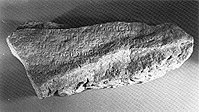Singapore Stone

A black and white photo of the Singapore Stone (above), and an artist's rendering of the inscriptions on the fragment of the Stone from an 1848 article by J.W. Laidlay published in the Journal of the Asiatic Society of Bengal (below)
|
|
 |
|
| Material | Limestone |
|---|---|
| Size | 67 cm (26 in), 80 kg (180 lb) |
| Writing | Unknown script; probably Old Javanese or Sanskrit |
| Created | At least 13th century, and possibly 10th or 11th century |
| Discovered | 1819 Mouth of the Singapore River |
| Present location | Displayed in the Singapore History Gallery at the National Museum of Singapore |
The Singapore Stone is a fragment of a large sandstone slab which originally stood at the mouth of the Singapore River. The large slab, which is believed to date back to at least the 13th century and possibly as early as the 10th or 11th century, bore an undeciphered inscription. Recent theories suggest that the inscription is either in Old Javanese or in Sanskrit, which suggested a possibility that the island was an extension of the Majapahit civilisation in the past.
It is likely that the person who commissioned the inscription was Sumatran. The slab may be linked to the legendary story of the 14th-century strongman Badang, who is said to have thrown a massive stone to the mouth of the Singapore River. On Badang's death, the Rajah sent two stone pillars to be raised over his grave "at the point of the straits of Singapura".
The slab was blown up in 1843 to clear and widen the passageway at the river mouth to make space for a fort and the quarters of its commander.
The Stone, now displayed at the National Museum of Singapore, was designated by the museum as one of 11 "national treasures" in January 2006, and by the National Heritage Board as one of the top 12 artefacts held in the collections of its museums.
In June 1819, a few months after the arrival of Sir Stamford Raffles (1781–1826) in Singapore, a sandstone slab about 10 ft (3.0 m) high and 9 to 10 ft (2.7 to 3.0 m) long was found by labourers clearing jungle trees at the southeast side of the mouth of the Singapore River. It stood at a promontory known as the Rocky Point, and later as Artillery Point, Fort Fullerton and the Master Attendant's Office. (In 1972, a short projection from the slab's site was constructed and a statue of an imaginary beast called the Merlion placed on it. The statue has since been relocated.) According to papers from the Journal of the Asiatic Society of Bengal which were collected by Sir William Edward Maxwell and republished in 1886, one Dr. D.W. Montgomerie said that the rock was brought to light by some Bengal sailors employed by Captain Flint, R.N., the first Master Attendant:
...
Wikipedia
